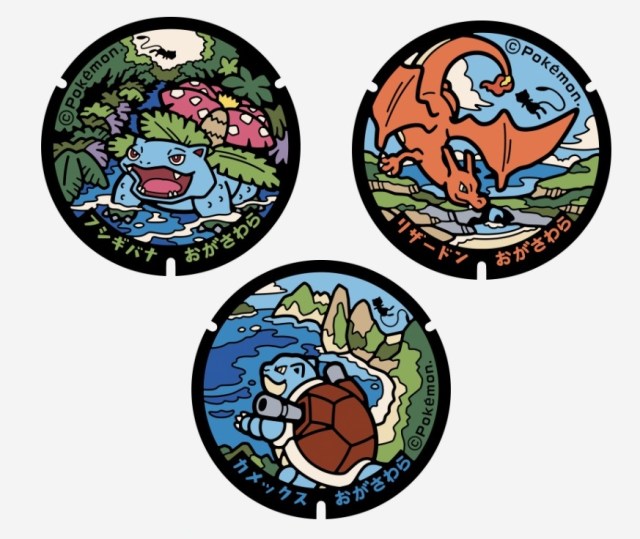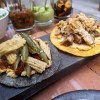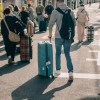
Pokémon Masters will need to spend an entire day traveling from Tokyo to spot the rarest of Gen I Pokémon and the evolved forms of the original three starters.
Out of the Generation I Pokémon, there’s no harder species to find than Mew. Unavailable in the original Pokémon Red/Green/Blue games and absent from the initial TV anime arc, it wasn’t until the first Pokémon movie that Mew made its official debut.
So it’s fitting that when the rarest of Pokémon gets its own Pokémon manhole cover, or Pokéfuta, as they’re officially called, it’s in an extremely remote location: Ogasawara, Tokyo.
“Wait a second,” you might be thinking. “How can part of Tokyo be ‘extremely remote?’ It’s the biggest city in Japan!” Yes that’s true, but Ogasawara is far from Shinjuku, Ginza, Akihabara, or any of the other central wards of Tokyo. Just how far outside downtown is it? About 1,000 kilometers (621 miles) to the south, across a vast stretch of ocean.
▼ Ogasawara (you’re going to need to zoom out to see the rest of Japan)
The town of Ogasawara, or Ogasawaramura, to use its full name, is on the island of Chichijima, part of the Ogasawara Islands (also known as the Bonin Island chain). While legally part of Tokyo, Ogasawara is obviously its own isolated community, and Mew making it its new home is a feather in the cap of the town’s roughly 2,500 residents.
Mew isn’t making the trip to Ogasawara alone, though. Last Saturday, which was also the 25th anniversary of the release of the first Pokémon games, Pokéfuta for Mew, Venusaur, Charizard, and Blastoise were all installed in the town, with the artwork showing the three maximum-evolved starter Pokémon frolicking in Chichijima’s tropical scenery while a silhouette of Mew can be spotted floating in the sky.
Exact locations for the four new Pokéfuta can be found here on the project’s official website.
So how do you get to Ogasawara? Well, there’s no airport on Chichijima, so the only option is a ferry that departs from downtown Tokyo’s Takeshiba Terminal and takes 24 hours to get there. But hey, it’s a trip you’ll never forget, and not only is Ogasawara a paradise of natural beauty, it’s also the only place in Tokyo that grows its own coffee beans.
Sources: Pokéfuta official website, PR Times
Top image: Pokéfuta official website
Insert images: PR Times, Pokéfuta official website
● Want to hear about SoraNews24’s latest articles as soon as they’re published? Follow us on Facebook and Twitter!




 Collect ’em all! New Pokéfuta accessories now available at Village Vanguard
Collect ’em all! New Pokéfuta accessories now available at Village Vanguard Pokémon manhole covers spreading with eight new Pokéfuta in Miyazaki
Pokémon manhole covers spreading with eight new Pokéfuta in Miyazaki Pokémon manhole covers come to Fukuoka with eight species appearing in Kitakyushu
Pokémon manhole covers come to Fukuoka with eight species appearing in Kitakyushu Finally! First-ever Pokémon manhole covers installed in downtown Tokyo
Finally! First-ever Pokémon manhole covers installed in downtown Tokyo Kinki Gyarados! Japan’s central region gets its first Pokémon manhole covers
Kinki Gyarados! Japan’s central region gets its first Pokémon manhole covers “Mt. Fuji convenience store” issues apology for bad tourist manners, adds multilingual signs
“Mt. Fuji convenience store” issues apology for bad tourist manners, adds multilingual signs Studio Ghibli releases new mug and tumbler collection featuring Jiji and Totoro
Studio Ghibli releases new mug and tumbler collection featuring Jiji and Totoro A guide to riding the Shinkansen bullet train with a terrible-twos kid
A guide to riding the Shinkansen bullet train with a terrible-twos kid Is the absolute closest conveyor belt sushi to Akihabara Station any good? Let’s find out!
Is the absolute closest conveyor belt sushi to Akihabara Station any good? Let’s find out! Tokyo tortilla restaurant is worth visiting whether you love or hate traditional Mexican cuisine
Tokyo tortilla restaurant is worth visiting whether you love or hate traditional Mexican cuisine The best kebab in Tokyo? We find out if Moses in Shibuya lives up to the hype
The best kebab in Tokyo? We find out if Moses in Shibuya lives up to the hype Cheap Japanese ryokan at Kusatsu Onsen is hidden at the back of a traditional store
Cheap Japanese ryokan at Kusatsu Onsen is hidden at the back of a traditional store Foreign shoppers in Akihabara tip us off to an awesome souvenir idea: DIY Paper Theater kit【Pics】
Foreign shoppers in Akihabara tip us off to an awesome souvenir idea: DIY Paper Theater kit【Pics】 This is Japan’s, and the world’s, first capsule hotel, and you can still stay there
This is Japan’s, and the world’s, first capsule hotel, and you can still stay there Tokyo sweets store sells beautiful soft serve ice creams that look like works of art
Tokyo sweets store sells beautiful soft serve ice creams that look like works of art McDonald’s Japan’s new pancake pie is a taste sensation
McDonald’s Japan’s new pancake pie is a taste sensation Bad tourist manners at Mt Fuji Lawson photo spot prompts Japanese town to block view with screens
Bad tourist manners at Mt Fuji Lawson photo spot prompts Japanese town to block view with screens FUK COFFEE?!? Japanese cafe has a perfectly innocent reason for its startling-looking name
FUK COFFEE?!? Japanese cafe has a perfectly innocent reason for its startling-looking name Studio Ghibli unveils new goods that tip the hat to The Cat Returns
Studio Ghibli unveils new goods that tip the hat to The Cat Returns How to make a secret rice bowl at Ichiran ramen
How to make a secret rice bowl at Ichiran ramen One of Japan’s oldest castles now lets travelers spend night on the grounds, drink in its keep
One of Japan’s oldest castles now lets travelers spend night on the grounds, drink in its keep Foreigner’s request for help in Tokyo makes us sad for the state of society
Foreigner’s request for help in Tokyo makes us sad for the state of society Two things to do, and two things not to do, when leaving a traditional Japanese inn
Two things to do, and two things not to do, when leaving a traditional Japanese inn Japan has nearly 4 million abandoned homes, but where and why?
Japan has nearly 4 million abandoned homes, but where and why? McDonald’s new Happy Meals offer up cute and practical Sanrio lifestyle goods
McDonald’s new Happy Meals offer up cute and practical Sanrio lifestyle goods Our Japanese reporter visits Costco in the U.S., finds super American and very Japanese things
Our Japanese reporter visits Costco in the U.S., finds super American and very Japanese things Japanese ramen restaurants under pressure from new yen banknotes
Japanese ramen restaurants under pressure from new yen banknotes All-you-can-drink Starbucks and amazing views part of Tokyo’s new 170 meter-high sky lounge
All-you-can-drink Starbucks and amazing views part of Tokyo’s new 170 meter-high sky lounge More foreign tourists than ever before in history visited Japan last month
More foreign tourists than ever before in history visited Japan last month Disney princesses get official manga makeovers for Manga Princess Cafe opening in Tokyo
Disney princesses get official manga makeovers for Manga Princess Cafe opening in Tokyo French Fries Bread in Tokyo’s Shibuya becomes a hit on social media
French Fries Bread in Tokyo’s Shibuya becomes a hit on social media Sales of Japan’s most convenient train ticket/shopping payment cards suspended indefinitely
Sales of Japan’s most convenient train ticket/shopping payment cards suspended indefinitely Sold-out Studio Ghibli desktop humidifiers are back so Totoro can help you through the dry season
Sold-out Studio Ghibli desktop humidifiers are back so Totoro can help you through the dry season Japanese government to make first change to romanization spelling rules since the 1950s
Japanese government to make first change to romanization spelling rules since the 1950s Ghibli founders Toshio Suzuki and Hayao Miyazaki contribute to Japanese whisky Totoro label design
Ghibli founders Toshio Suzuki and Hayao Miyazaki contribute to Japanese whisky Totoro label design Tokyo’s most famous Starbucks is closed
Tokyo’s most famous Starbucks is closed Doraemon found buried at sea as scene from 1993 anime becomes real life【Photos】
Doraemon found buried at sea as scene from 1993 anime becomes real life【Photos】 One Piece characters’ nationalities revealed, but fans have mixed opinions
One Piece characters’ nationalities revealed, but fans have mixed opinions We asked a Uniqlo employee what four things we should buy and their suggestions didn’t disappoint
We asked a Uniqlo employee what four things we should buy and their suggestions didn’t disappoint New Japanese KitKat uses cacao grown in Tokyo
New Japanese KitKat uses cacao grown in Tokyo Brand-new Pokémon manhole covers coming to Japan’s snowy Hokkaido Prefecture!
Brand-new Pokémon manhole covers coming to Japan’s snowy Hokkaido Prefecture! Pathetically weak Magikarp shown love with Pokémon manhole covers in birthplace of koi culture
Pathetically weak Magikarp shown love with Pokémon manhole covers in birthplace of koi culture Tochigi Prefecture’s three new Pokéfuta are the first in the north of Japan’s Kanto region
Tochigi Prefecture’s three new Pokéfuta are the first in the north of Japan’s Kanto region Pokémon come to real-life Johto region with new Pokémon manhole covers for Nara【Pics】
Pokémon come to real-life Johto region with new Pokémon manhole covers for Nara【Pics】 Brand-new Pikachu manhole covers coming to Japanese city to celebrate Pokémon World Championships
Brand-new Pikachu manhole covers coming to Japanese city to celebrate Pokémon World Championships Kyoto now has Pokémon manhole covers as Generation 2 comes to the real-life Johto region
Kyoto now has Pokémon manhole covers as Generation 2 comes to the real-life Johto region Eight new Pokémon manhole covers featuring Vulpix spawn in snowy Hokkaido Prefecture
Eight new Pokémon manhole covers featuring Vulpix spawn in snowy Hokkaido Prefecture Five new Pokémon manhole covers arrive in Tottori Prefecture, now with one in every municipality
Five new Pokémon manhole covers arrive in Tottori Prefecture, now with one in every municipality Pokémon manhole covers make their debut in Japan’s Aomori Prefecture
Pokémon manhole covers make their debut in Japan’s Aomori Prefecture Saitama Prefecture scores its first Pokémon manhole covers in Tokorozawa City
Saitama Prefecture scores its first Pokémon manhole covers in Tokorozawa City Brand-new Pokémon manhole covers have Sandshrew welcoming you to an often forgotten part of Japan
Brand-new Pokémon manhole covers have Sandshrew welcoming you to an often forgotten part of Japan Fiery balls of lava erupting from Nishinoshima eruption caught on video
Fiery balls of lava erupting from Nishinoshima eruption caught on video Japan’s Pokémon manhole covers travel to you in new line of mugs, replicas, and other merch【Pics】
Japan’s Pokémon manhole covers travel to you in new line of mugs, replicas, and other merch【Pics】 Miyazaki Prefecture celebrated Exeggutor Day by installing nine more Exeggutor-themed Pokéfuta
Miyazaki Prefecture celebrated Exeggutor Day by installing nine more Exeggutor-themed Pokéfuta Japanese prefecture that named a Pokémon as its governor to install 16 new Pokémon manholes
Japanese prefecture that named a Pokémon as its governor to install 16 new Pokémon manholes
Leave a Reply